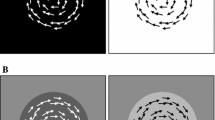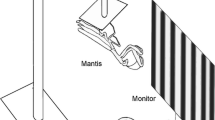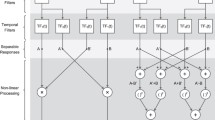Abstract
To follow visually a small object moving in front of a textured background, insects and vertebrates can employ a similar strategy: saccadic tracking. In the case of vertebrates, the neural components that generate this behavior are not known in detail. The neural substrate of optomotor behavior in Diptera is relatively well understood. Here a model developed from the dipteran data is found to be capable of saccadic tracking. It is characterized by the following components and functions: (1) Two subsystems contribute to the response, a small-field tracking system and a large-field compensatory optomotor system, as suggested previously (Egelhaaf et al. 1988). (2) Both systems need to be suppressed during saccadic rotation. In the small-field system, the suppression, close to the visual input, is mediated by the activity of the large-field system. In the large-field system, suppression, close to the motor output, is due to efferent signals from the saccade generator. A similar model could also apply to vertebrates. Two implications of the present model are that saccadic tracking does not require object identification, and under saccadic tracking it is the background rather than the object that is stabilized on the retina. If objects are identified under these conditions, this must occur even though their image is not stabilized on the retina.
Similar content being viewed by others
References
Bilo D (1989) Optocollic reflexes and neck flexion-related activity of flight control muscles in the airflow-stimulated pigeon. In: Second Symposium on Head Movement Control, The Head-Neck Sensory-Motor System, Fontainebleau
Collett TS (1980) Angular tracking and the optomotor response. An analysis of visual reflex interaction in a hoverfly. J Comp Physiol A 140:145–158
Carpenter RHS (1988) Movements of the eyes, 2nd edn. Pion, London
Egelhaaf M (1985) On the neuronal basis of figure-ground discrimination by relative motion in the visual system of the fly. III. Possible input circuitries and behavioural significance of the FD-cells. Biol Cybern 52:267–280
Egelhaaf M (1987) Dynamic properties of two control systems underlying visually guided turning in house-flies. J Comp Physiol [A] 161:777–783
Egelhaaf M (1990) Spatial interactions in the fly visual system leading to selectivity for small-field motion. Naturwissenschaften 77:182–185
Egelhaaf M, Hausen K, Reichardt W, Wehrhahn C (1988) Visual course control in flies relies on neuronal computation of object and background motion. TINS 11:351–358
Heisenberg M, Wolf R (1984) Vision in Drosophila. Springer, Berlin Heidelberg New York
Hengstenberg R (1991) Gaze control in the blowfly Calliphora: a multisensory, two-stage integration process. Semin Neurosci 3:19–29
Ilg UJ, Brenner F, Thiele A, Hoffmann KP (1992) Neuronal coding of retinal slip during smooth pursuit eye movements. Eur J Neurosci (Suppl) 5:253
Kirschfeld K (1991) An optomotor control system with automatic compensation for contrast and texture. Proc R Soc Lond [Biol] 246:261–268
Nalbach H-O (1989) Three temporal frequency channels constitute the dynamics of the optokinetic system of the crab, Carbius maena (L). Biol Cybern 61:59–70
Land MF (1992) Visual tracking and pursuit: Humans and arthropods compared. J Insect Physiol 38:939–951
Lässig P, Kirmse W, Yekoye A (1987) Visuomotor control by a combined position- and speedservo. Theoretical considerations and experimental results in man. Syst Anal Model Simul 4:321–334
Reichardt W (1961) Autocorrelation, a principle for evaluation of sensory information by the central nervous system. In: Rosenblith WA (eds) Principles of sensory communication. Wiley, New York, pp 303–317
Reichardt W, Poggio T (1979) Figure-ground discrimination by relative movement in the visual system of the fly. Biol Cybern 35:81–100
Rossel S (1980) Foveal fixation and tracking in the praying mantis. J Comp Physiol 139:307–331
Thorson J (1966) Small-signal analysis of a visual reflex in the locust. Kybernetik 3:53–66
Wagner H (1986) Flight performance and visual control of flight of the freeflying housefly (Musca domestica L.). III. Interactions between angular movement induced by wide- and smallfield stimuli. Philos rans R Soc Lond [Biol] 312:581–595
Westheimer G, McKee SP (1975) Visual acuity in the presence of retinal-image motion. J Opt Soc Am 65:847–850
Wolf R, Heisenberg M (1990) Visual control of straight flight in Drosophila melanogaster. J Comp Physiol A 167:269–283
Author information
Authors and Affiliations
Rights and permissions
About this article
Cite this article
Kirschfeld, K. Tracking of small objects in front of a textured background by insects and vertebrates: phenomena and neuronal basis. Biol. Cybern. 70, 407–415 (1994). https://doi.org/10.1007/BF00203233
Received:
Accepted:
Issue Date:
DOI: https://doi.org/10.1007/BF00203233




